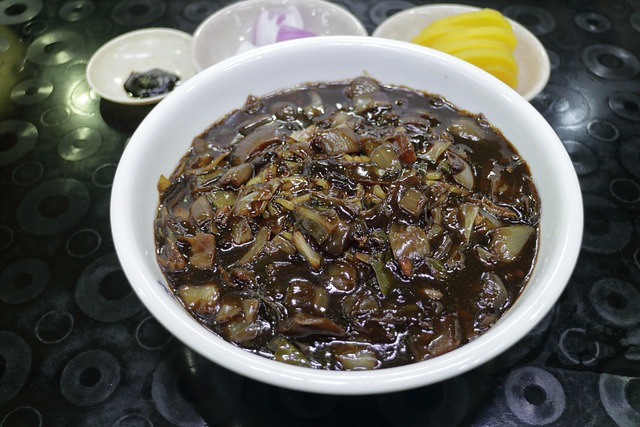Tracing Its Historical Roots

The story of Korean Jjajangmyeon begins in the early 20th century, during a period of cultural exchange between Korea and China. Chinese immigrants, primarily from the Shandong province, settled in Korea, bringing with them their culinary traditions. Among these traditions was a dish called “zhá jiàng miàn” (炸酱面) in Mandarin, which translates to “fried sauce noodles.”
As Chinese immigrants adapted to their new environment in Korea, they began to modify traditional Chinese dishes to suit Korean tastes and ingredients. This led to the creation of what is now known as Jjajangmyeon, a unique fusion of Chinese-style noodles and Korean flavors.
The exact origins of Jjajangmyeon are somewhat debated, but it is believed to have emerged in the early 20th century in Incheon, a port city in South Korea with a significant Chinese immigrant population. The dish was initially popularized in Chinatown areas of major cities like Incheon, Seoul, and Busan, where Chinese immigrants ran restaurants and food stalls.
Originally, Jjajangmyeon was a humble street food enjoyed by laborers and working-class Koreans. It was affordable, filling, and offered a comforting mix of flavors. Over time, as Korea underwent rapid industrialization and urbanization, Jjajangmyeon evolved from a street food into a beloved staple of Korean cuisine.
Today, Jjajangmyeon holds a special place in Korean culinary culture, enjoyed by people of all ages and backgrounds. It is commonly eaten as a quick meal or takeout option, often accompanied by tangsuyuk (sweet and sour pork) and pickled radish. While its roots may lie in Chinese cuisine, Jjajangmyeon has become an iconic dish in its own right, symbolizing the rich culinary heritage and cultural exchange between Korea and China.
Exploring the Rich History and Flavorful Delights of Korean Jjajangmyeon
In the bustling landscape of Korean cuisine, few dishes rival the popularity and comfort of Jjajangmyeon. This iconic dish, with its roots deeply embedded in Korean-Chinese culinary traditions, has captivated the taste buds of millions with its rich history and irresistible flavor.
The Flavorful Symphony
At the heart of Jjajangmyeon lies its signature sauce, made from fermented black soybean paste, caramelized onions, pork or seafood, and a hint of sweetness. This savory and umami-rich sauce is then generously ladled over chewy noodles, creating a harmonious marriage of flavors and textures that tantalizes the palate.
Savoring the Experience
Eating Jjajangmyeon is not just a culinary delight but a cultural experience in itself. Whether enjoyed at a bustling Jjajangmyeon restaurant or savored in the comfort of one’s home, each bite of these noodles tells a story of tradition, innovation, and the shared love for good food.
Variations and Adaptations
While the classic version of Jjajangmyeon remains a timeless favorite, there are also variations and adaptations that cater to different preferences. From spicy variations to vegetarian-friendly options, Jjajangmyeon continues to evolve while staying true to its roots.
A Culinary Icon
In modern Korean culture, Jjajangmyeon holds a special place as a beloved comfort food enjoyed by people of all ages. Whether as a quick meal during a busy day or a celebratory feast with loved ones, Jjajangmyeon has become synonymous with warmth, nostalgia, and the simple joy of good food.
Korean Jjajangmyeon is more than just a dish; it is a culinary journey that embodies the rich tapestry of Korean-Chinese culinary fusion. With its fascinating history, complex flavors, and widespread popularity, Jjajangmyeon continues to delight and comfort food lovers around the world, inviting them to savor a taste of Korea’s vibrant culinary heritage.